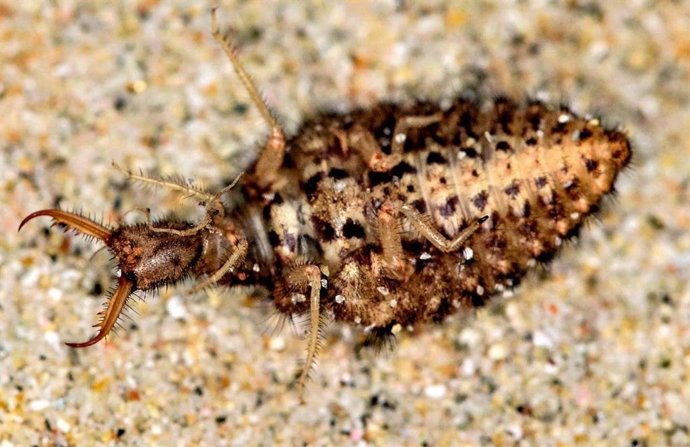An antlion larva (Euroleon nostras) playing dead – PROFESSOR NIGEL R FRANKS, UNIVERSITY OF BRISTOL
Aug. 27 () –
A new study has revealed what animals do after pretend to be dead to avoid being victims of a predator and in what context this behavior occurs.
Many animals, as a last resort for defense, remain motionless after coming into contact with a predator. This behavior is so common that it is recognized in phrases such as “playing dead.” It is even said that It occurs in humans in extreme circumstances.
In previous studies, carried out with antlion larvae by the same team -led by the University of Bristol-, scientists observed that They remained motionless after being manipulated individually.
At one point, it was necessary to weigh the larvae, which with such small insects can be very difficult, since if they move on the scale plate, Determining its mass can be a challenge.
However, when antlion larvae were dropped, very gently, onto a weighing pan, they remained completely stationary for more than enough time for their weight to be accurately recorded.
Emeritus Professor Nigel Franks from the University of Bristol’s School of Biological Sciences, who led the study, said in a statement: “We decided to investigate this so-called ‘death-feigning’ behavior and found that the amount of time antlions remain stationary is completely unpredictable for any individual.
“This is confirmed by observing the duration of post-contact immobility in a large number of antlions. These data show an exponential distribution. So, as with radioactive atoms, the timing of an individual’s state change is unpredictable, but the population pattern is perfectly predictable“.
The study shows that the behavior of antlions hiding in plain sight in this way is likely adaptive because a predator that has picked up and then released an antlion larva would not be able to know how long to wait for its potential victim to move again and once again become recognizable prey. In fact, One of the recorded antlions remained completely stationary for over an hour.
Although it is not possible to predict when a motionless antlion will come back to life, this does not mean that the predator has necessarily left the scene to seek alternative prey.
The team’s next question was what the animals do after playing dead. In the new study, they show that what antlions do It depends on the situation they are in.
Antlion larvae are burrowing animals and may seek safety by burrowing into the friable substrate where they normally build their burrows. But it is quite possible for a predator to drop an antlion onto a hard substrate that would not allow it to escape.
Using sophisticated automated video tracking of the intermittent locomotion of individual antlions on different substrates, the researchers discovered what an antlion does after finishing its period of immobility depends on the escape strategies available.
Professor Franks added: “Our study may well be the first to determine what animals do after they have played dead, and we show that what they do depends on the context. It is a dilemma. “Our work thus opens the field of study of life after death in the enormous variety of animals that present death simulation, thanatosis or what we prefer to call post-contact immobility.”









![[Img #74683]](https://thelatestnews.world/wp-content/uploads/2024/12/The-main-mistakes-to-avoid-when-betting-on-electronic-sports-150x150.jpg)




![[Img #74683]](https://thelatestnews.world/wp-content/uploads/2024/12/The-main-mistakes-to-avoid-when-betting-on-electronic-sports-300x200.jpg)

Add Comment